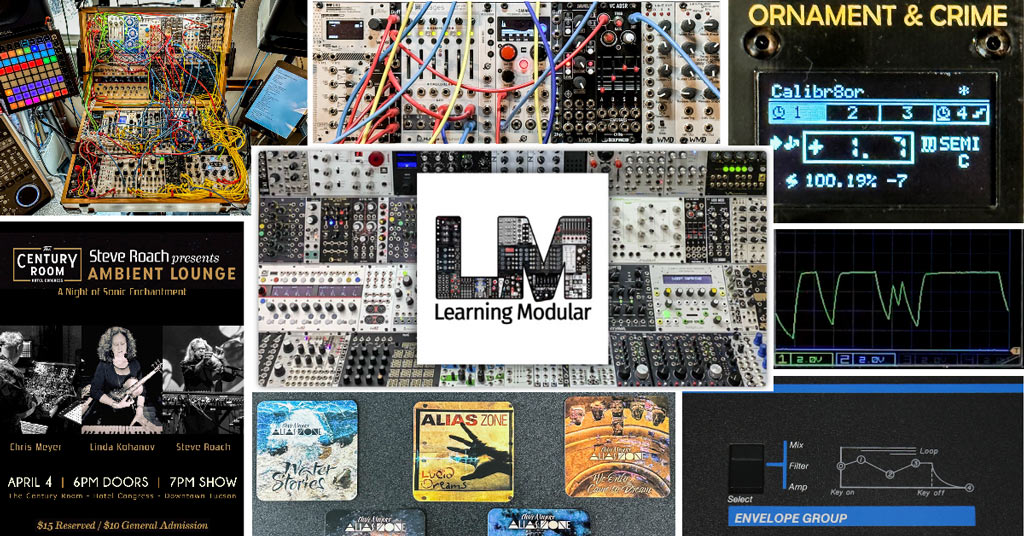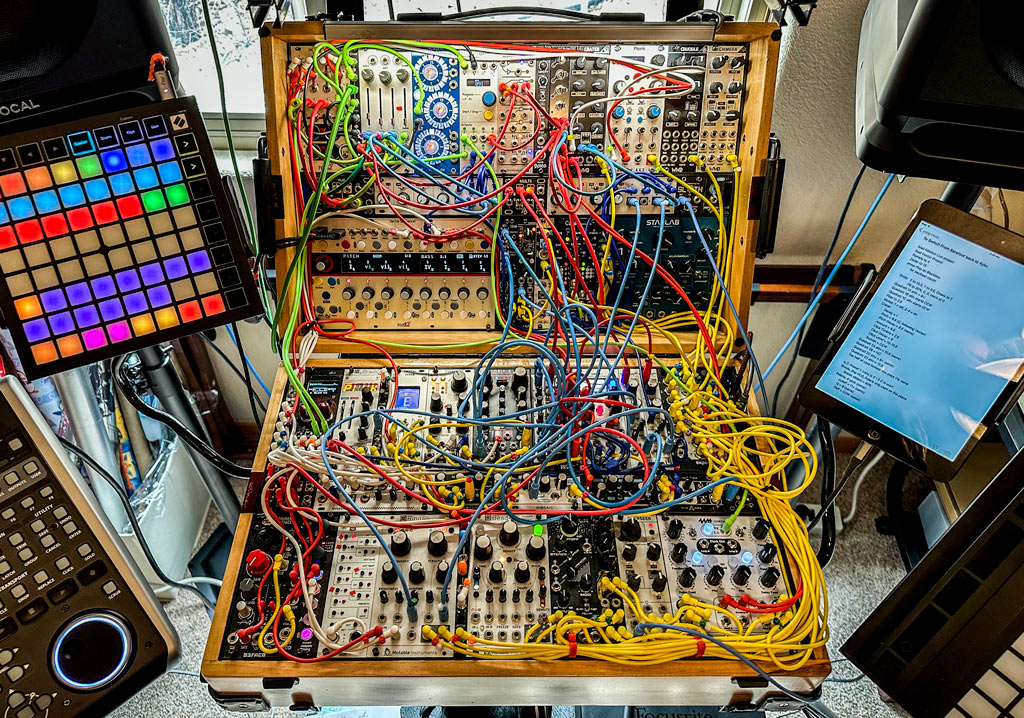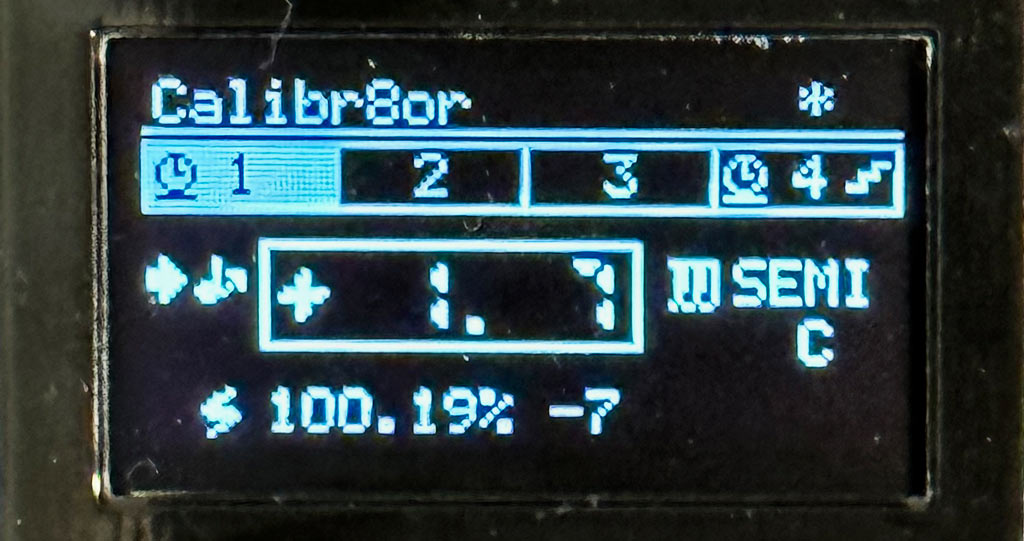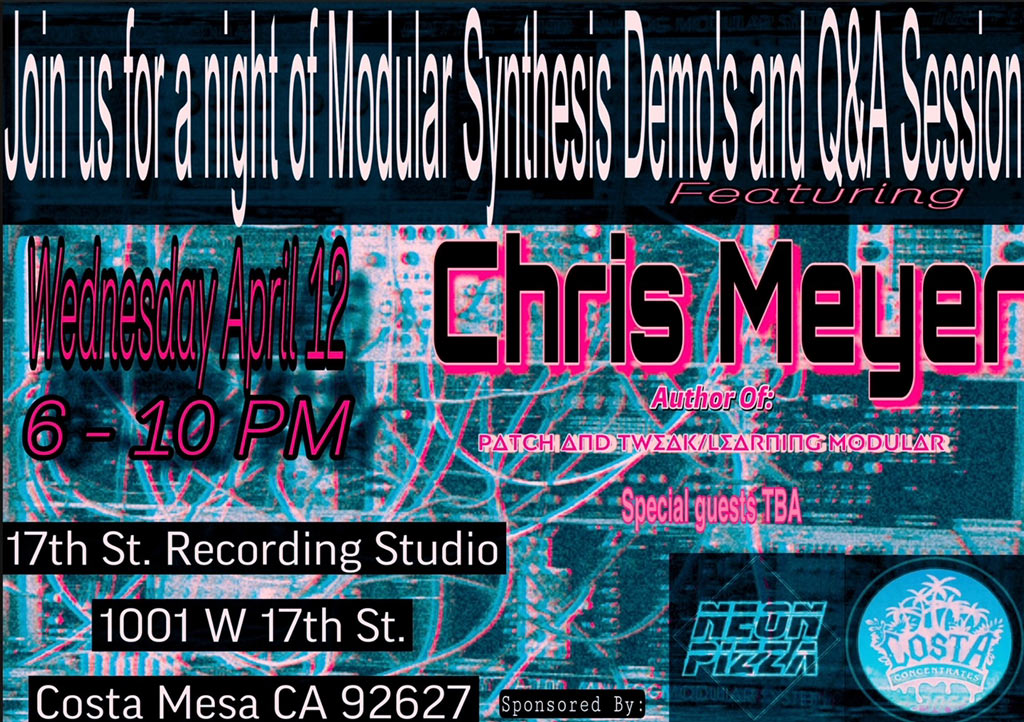When I wrote this, I was in the final rehearsal push before going on a mini-“tour” during the first half of April, ending up at the NAMM show in Anaheim, California. Last year played 9 live events, traveling to each one individually; I’m seeing if I can be more efficient about that this year.
One of my goals this year is also learning how to play longer sets without bringing more gear. That’s requiring an overhaul of my performance system, which I outline in the main article this month. Other topics include:
- featured article: How can I play a wider variety of musical material on the same setup – without making the audience wait while I re-patch?
- Alias Zone updates: Tone Science: Cause and Effect (plus, stickers!)
- Learning Modular updates: Creating some custom tools for both the studio and performance.
- Patreon updates: In addition to a demo of my favorite Mutable Instruments modules, I’m also starting two new series for my subscribers: details on the updates to my performance system, and what features I look for when I shop for specific modules.
- upcoming events: I’m staging a mini-tour the first half of this month (April 2023), leading up to this year’s NAMM show. Plans are also coming together for another tour in October’
Refining (and Stretching) My Live Performance System
Our story so far…
When my dear bassist friend Lachlan Westfall declared he wanted to “get the band back together” for his 60th birthday a few years ago, he asked me if I could be part of it. Back when we used to play together, my performance rig was centered around layering loops and ambiences in Ableton Live, and performing a live “dub mix” of them during our performances. As I had since moved onto modular – and was working DAW-less at the time – I put together a case devoted to improvising percussion and rhythms, along with ambiences and a few other sounds.
That went well enough that my happy place for a couple of years was using that system to act as “the drummer” when improvising with a variety of other modular musicians. But when Covid hit, I put that system aside, and devoted myself to composing extended solo works using my studio modular plus a few hardware synths. This is also when Ableton Live started creeping back into my life, also acting as a digital mixer and recorder (with the occasional virtual instrument).
When we could start playing out again, I was enjoying my new life as a solo act…but I couldn’t bring my entire studio out with me. So with the help of my good friend Trovarsi, I re-imagined my performance rig as a hybrid modular + laptop system, with the goal of recreating the range of sounds I could get out of my studio system. To put it to the test, I scheduled a number of live performances last year, composing 15-30 minute sets to play on the new system. And it went very well.
This year, I set the goal for myself of being able to playing longer sets which move between two or more pieces (which often sound rather different from each other). That requires a further re-imagining of my performance system, as a single meta-patch has to be able to play multiple works, and I have to be able to move between them without “losing the dance floor” making the audience wait while I re-patch.
For my first steps down this new, longer road, I have a series of three gigs coming up the first half of April, with two of them featuring two half-hour pieces. So not only have I been composing a new piece for these gigs, I also had to figure out some strategies for how to play two different pieces back to back. Here’s some of the changes I’ve made to hopefully accomplish this goal.
More Voices…and the Right Voices
My current gigging case was custom-built to meet US airline regulations (plus I’m at my luggage limits bringing all of the rest of the gear as well), so expanding is out of the question. The first challenge, therefore, was to find a way to add another voice or two without requiring more space.
The original system really had just one “synth voice”, consisting of a µBraids 2 and a Klavis Twin Waves MKII for the oscillators, an Intellijel Polaris for the filter, and one half of the Arcus Audio 1U dual VCA. I decided I wanted to have two entire synth voices for the new system, for more flexibility.
I have been working with the ModBap Osiris wavetable oscillator, and I really like it. It has the ability to layer its main voice with itself and detune it, plus it has a suboctave – so that’s the equivalent of at least two VCOs right there (the Twin Waves has a suboctave output as well). I’ve been making my own wave banks for it, based on sampling my studio modular so I could have some of my favorite sounds from my various VCOs, filters, and multi-module patching tricks inside my gigging case. For a filter, I’m currently using a Mosaic 1U four-pole Low Pass Filter, plus the VCA is the other half of the Arcus.
To make room, I had to slim down the space the first synth voice was using, so I reluctantly removed the Twin Waves MKII and replaced it with a 2hp analog VCO to layer with the µBraids. To open up more room in that half of the case, I also removed the Mosaic 1U Plucked String (I already have a Mutable Instruments Rings plus a 2hp Pluck in there), and the DivKid/Befaco Stereo Strip (I was already doing the rest of my EQ in the laptop).
I also needed to open up some room in the top half of the case, so I stared long and hard at the percussion and effects modules in it. I had been using an Expert Sleepers Disting mk4 just for sampled kick drums and other noise effects, but I had already been moving toward triggering more samples in the laptop over MIDI from the Five12 Vector sequencer, so that came out.
More Signal; More Switches
I already had a lot of attenuators in the case to adjust modulation depths, but I’ve had a few occasions where I needed to boost signals as well – so that became a priority. The Mutant Modular Attenuverter has a gain of 2x on its first channel, so it stayed. Someone recommended the new Klavis Tweakers utility mixer as both of its channels have a 2x gain, so it replaced the Złob MiniAtt.
My goal is to minimize the amount of re-patching I have to do on the fly; I want everything for both pieces patched up and ready to go at the start of the set. There are some modulation or signal routings I need for one piece, but not the other. I could route those through another attenuator or utility mixer…but a simple mechanical switch works as well, and is faster to use. The Złob MiniAtt I removed has switches for its two channels, but so does the Klavis Tweakers I added in its place – so it’s a wash there. I added the DIvKid Mutes module back into the case to give me four more switches.
I also realized that some digital modules have virtual attenuators and switches. The Xaoc Devices Zadar modulator also has level controls on each of its four outputs, and the ALM Pamela’s New Workout has a programmable mute for each of its eight channels. Both can also save and load presets, which is another important feature when trying to get the same patch to make different sounds quickly. So, changing presets not only changes the function of each of their outputs, they can also switch them off if I need to.
Covering Transitions
Some musicians build one large sequence or project in their DAWs to cover their entire performance. I was concerned that having that many samples loaded and plugins running would demand a lot of resources from my laptop, plus it might mean a lot of tweaking and muting/unmuting of mix channels – so I’ve decided to change projects in Ableton Live between pieces, which means the entire mix automatically changes as well.
I need a way to cover for the time required to load a new project plus change settings on the modular; again, I don’t want to make the audience wait while I fiddled around. In the old days, electronic musicians would program drones to cover their re-patching and knob tweaking between pieces; today, many people sample and play back ambiences or other sonic “holding patterns” while they re-patch.
To that end, I decided to add the 1010music Blackbox back to my setup, as I could load long textures into it (I tend to have rather “atmospheric” openings to my pieces anyway, often based on field recordings, arpeggiations, or drones). It also has a filter and effects to help make those textures more interesting.
The next challenge is how to hear the Blackbox during those transitions, because when the laptop is loading a new project, it mutes the outputs. Last year I added a Focsurite Clarett+ 4Pre to my system for non-modular inputs plus quadraphonic outputs. Focusrite ships a nice little free control app with it that allows you to set up monitor mixes that can pass the inputs directly to the output without going through the computer (other interfaces can do this as well). By making the 4Pre my main output, and patching the Blackbox into it, I can keep sound going to the speakers while my “mixer” is busy being loaded with the new Live project.
To The Test…
I will find out very soon if all of this planning is going to work! Plus, every gig is a learning experience that helps me further refine my system.
I have a few other goals for this updated system as well, such as making it easier to move patches from my big studio modular to this smaller gigging system. I’ll be documenting the full journey on my Patreon channel.
Alias Zone Updates

Also, there’s a few generalizations you can make about modular musicians (and, well, electronic musicians in general): they tend to like cats (you’ve seen the cats on synthesizers in space memes, right?), and they tend to love stickers. So, I printed a set of stickers based on my album covers, which I will be giving away at my performances this year. If you can’t make one of my performances, and would like a set of stickers, use the Contact form at the bottom of this page to send me your address, and I will send you a set!
Learning Modular Updates
This is an example of where my right-brain Alias Zone pursuits and my left-brain Learning Modular pursuits cross over: As I compose and perform music, I’ve learned that there’s a few tools I need that don’t quite exist in a form I like – so I’ve been working on creating them (or cajoling others to create them for me). One is the alternate wave banks for the ModBap Osiris I mentioned briefly above; I’ll be writing more on that later when it’s finished and ready to be shared with others. Another is an alternate arpeggiator for Ableton Live that is better suited for slow harmonic evolutions.
The one that is ready now (more or less? we think it is?) is alternate firmware for the Ornament & Crime (o_C) general purpose Eurorack module. I’ve been working with Nick Michalek (aka DJ Phazer) on this, and he’s done a great job. In short, it provides four channels of:
- quantization – either to semitones, or scales (including user-defined scales)
- octave and semitone offsets (semitones are replaced with scale degrees when you select a scale)
- tracking adjustment, with sharp/flat “tilt” in the pitch control voltage adjustable in 0.01% increments (no need to tweak the trimmers on your oscillators!)
- pitch offset, with sub-cent precision (no more fighting with fiddly fine tune knobs!)
- optional sample & hold capabilities, holding off changes to just transposition or to both input voltage plus transposition until a trigger is received
- four user presets of all of the above, saved in non-volatile memory
- all with a very flat, immediate user interface
Later this spring when I have time, I will create a video demonstrating this in detail. In the meantime, click here to download the firmware (part of Nick’s Phazerville Suite for the o_C hardware), and click here for the instructions on how to use it.
Patreon Updates
During March, I did a live Zoom demo for both my Patrons and subscribers to Trovarsi and ALX-106’s TheSoundLab channel on several of my favorite Mutable Instruments modules (and clones). Thank you to all of my subscribers who voted on which modules to cover. For those who could not attend, Trovarsi will be editing the video and posting it later; I’ll let my subscribers know the link when it becomes available.
Other posts last month include:
- The introduction to a new series on updates to my performance system, which will go into much more detail beyond the main article above
- The first of a new series on what I look for when I buy certain types of modules; this one is a very in-depth description of what features I look for in envelope generators, including patch tips as well as feature ideas for module creators and those coding their modules
- A chance to buy more modules I’m letting go of, at steeply discounted prices
In the near future, I’ll also be breaking down the most recent track I composed for my upcoming tour, and what I find interesting as the upcoming Superbooth show in Berlin.
For those who are not already subscribers, the +5v level – $5/month – gets you immediate access to a library of literally hundreds of posts as well as new ones each month, while $12/month adds access to my Eurorack-focused online modular synthesis courses. Why don’t you consider subscribing, if even for a month to catch up on all the stuff I’ve written about already?
Upcoming Events
I am looking forward to my mini-tour in southern Arizona & California in the first half of April, leading up to the 2023 NAMM show. Stops will include:
April 4 – Tucson, Arizona: I will be part of Steve Roach’s Ambient Lounge series at the Century Room in Tucson, Arizona. Doors open at 7; we start playing at 8. Steve’s wife Linda Kohanov will play first, live-looping and processing her five-string electric viola. I will then play a new, roughly half-hour set, followed by Steve. Tickets are available by following this link. The $15 ticket gets you a seat at one of the front tables so you can more closely watch what we’re doing. (Plus the bar has some really inventive drinks, with and without alcohol.)
April 8 – Phoenix, California: I was supposed to share an evening with Jill Fraser at FurstWurld in Joshua Tree, California, but unfortunately they ran into permitting issues. So instead, I will be headline a large private house party in Phoenix, which will include other acts like Tony Obr’s trio Slender Loris (seen above). If you live in that area and are interested in attending, use the Contact form below and I’ll see if I can get you in.
April 12 – Cost Mesa, California: I will be giving a performance plus Q&A at 17th Street Recording Studio in Costa Mesa, California the evening before the NAMM show (the studio is only 15 minutes away from the convention center!). Doors open at 6; I’ll be going on at 7, followed by other special guests. It should be quite an event, and a nice way to socialize in a more intimate setting before the NAMM show starts. Did I mention it was free? And did I mention there would be pizza?
I am also piecing together a tour around a few cities in North Carolina the first half of October of this year. I might even be in the New England area before that. And, I suspect I’ll be playing the Chill Out Room at Knobcon again this year in September. I’ll keep you posted.
I always feel a mixture of excitement and apprehension when I get ready to perform: I am anxious to share what I’ve been working on with my fellow electronic musicians and music lovers, but I also worry about whether I have prepared for every contingency in case something goes wrong. This is heightened by having updated my gigging case, plus bringing along a few new items (including hand percussion) that I’ve not performed live with before. This is offset by really enjoying the music I’m creating these days, and wanting to make a connection with more potential listeners. I hope you’re one of them.
moving forward –
Chris







